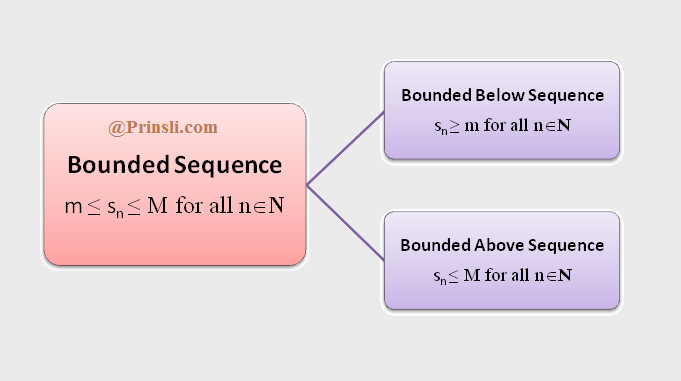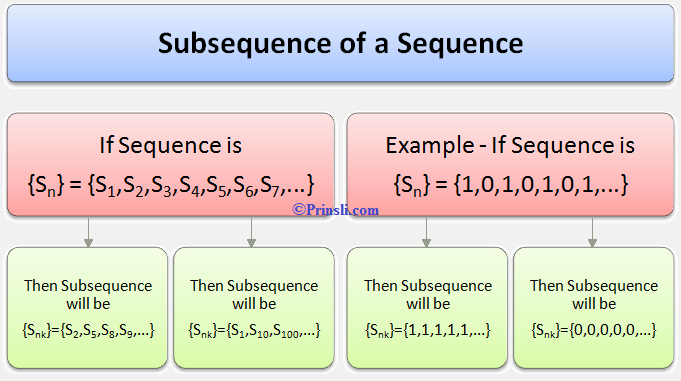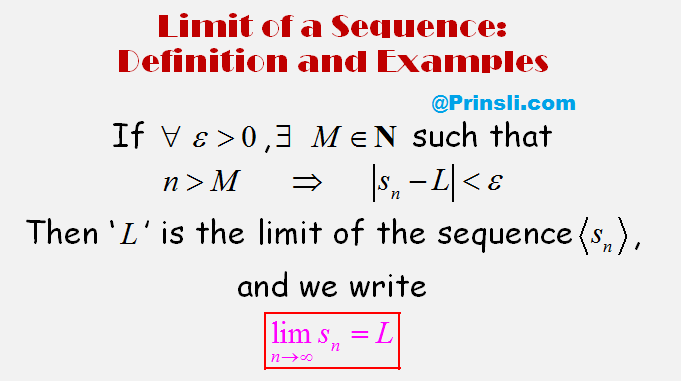
Bounded Below Sequence –
A sequence {} is said to be bounded below if the range set of {
} is bounded below. A sequence is bounded below if there exists a fixed real number
, such that, all terms of the sequence are greater than or equal to the number
.
In mathematical words, a sequence {} is said to be bounded below if
for all
N,
where is some fixed real number.
Sometimes, the number is called a lower bound of the sequence, and the greatest lower bound is called the infimum.
Bounded Above Sequence –
A sequence {} is said to be bounded above if the range set of {
} is bounded above. A sequence is bounded above if there exists a fixed real number
, such that, all terms of the sequence are less than or equal to the number
.
In mathematical words, a sequence {} is said to be bounded above if
for all
N,
where is some fixed real number.
Sometimes, the number is called an upper bound for the sequence, and the smallest upper bound is called the supremum.
Bounded Sequences –
A sequence {} is called a bounded if it is bounded both above and below, that is to say, if there is a number,
, less than or equal to all the terms of the sequence and another number,
, greater than or equal to all the terms of the sequence. Therefore, all the terms in the sequence are between
and
.
In mathematical words, a sequence {} that is bounded both above and below is called a bounded sequence, that is,
for every
N.
In other words, a sequence {} is bounded if and only if there exists a real number
such that
for all
N.
Remarks & Properties of Bounded Sequences –
- Bounded sequences can be bounded above by the sequence’s largest value and bounded below by the sequence’s smallest value.
- If a sequence is an increasing monotonic sequence, then the smallest value of this sequence will be its first term, that is,
. In this case,
for all
N,
and so increasing monotonic sequences are always bounded below.
- If a sequence is a decreasing monotonic sequence, then the largest value of this sequence will be its first term, that is,
. In this case,
for all
N,
and so decreasing monotonic sequences are always bounded above.
- To see if the monotonic sequence’s end is bounded, we have to take the sequence’s limit as
. If we get a real-number answer for this limit, the sequence is definitely bounded both at the end and at the beginning.
Unbounded Sequence in Mathematics:
A sequence {} is said to be unbounded if it is either unbounded below or unbounded above.
Read Also: Bounded Sequence Examples
Copyrighted Material © 2019 - 2024 Prinsli.com - All rights reserved
All content on this website is copyrighted. It is prohibited to copy, publish or distribute the content and images of this website through any website, book, newspaper, software, videos, YouTube Channel or any other medium without written permission. You are not authorized to alter, obscure or remove any proprietary information, copyright or logo from this Website in any way. If any of these rules are violated, it will be strongly protested and legal action will be taken.




Be the first to comment